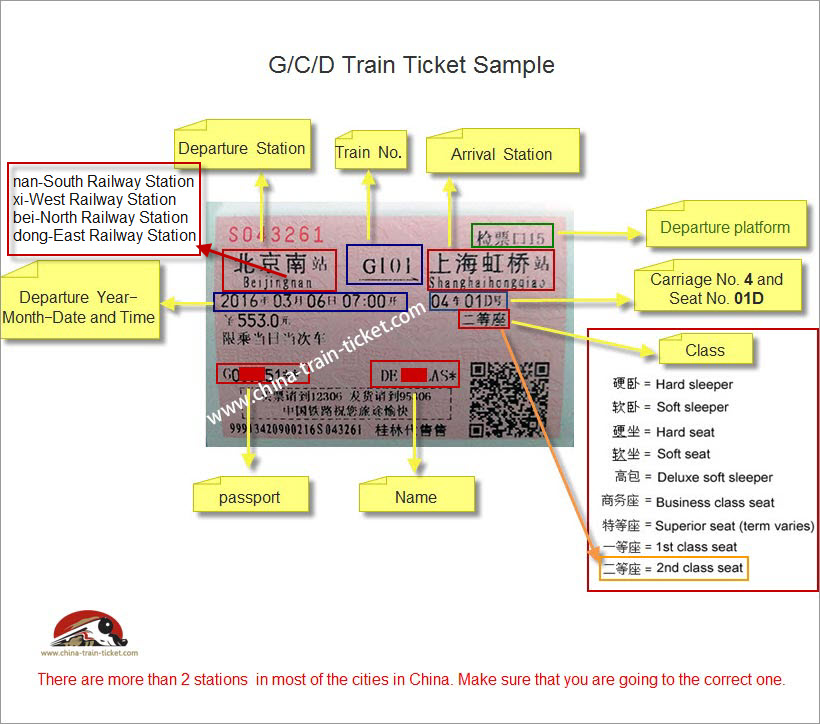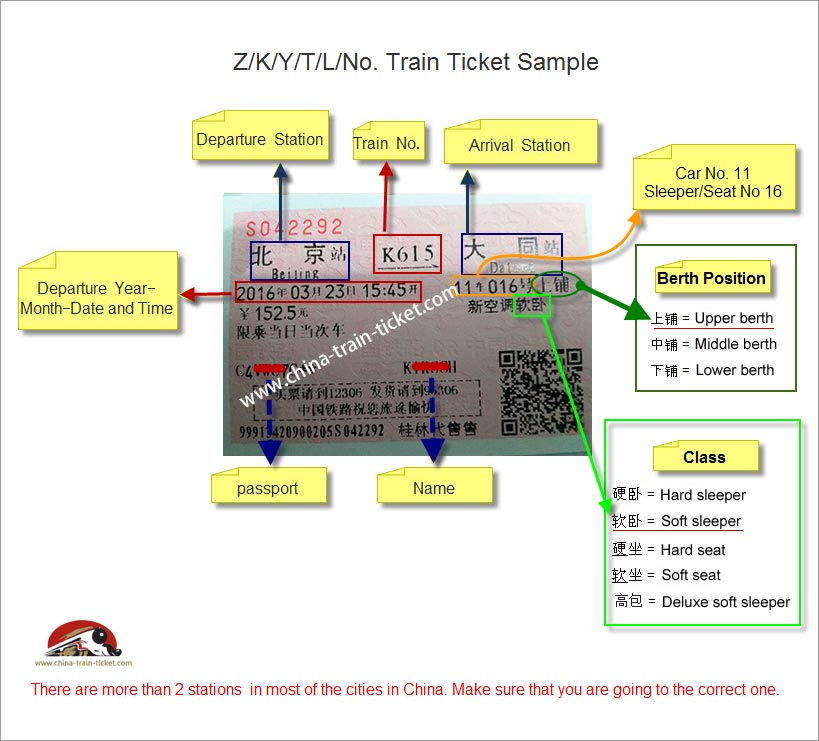Passenger trains in China are identified by their classes of service according to their speeds. The train number usually starts with a capital letter that stands for the class of service. For example, Z19 refers to a direct express train and D316 an electrical multiple unit.
High speed, intercity and electrical multiple unit are known as the best classes of service in China for their modern facilities and high speed. Most of the trains of this class can travel 200-300 km/h during the daytime. Some electrical multiple units can reach a maximum speed of 200 km/h.
High Speed Trains - G
Long-distance high-speed service is among the fastest in China, with a maximum speed of 350 km/h. But speed limits may be imposed accordingly on different railway lines, with the speed ranging from 200 km/h to 300 km/h.
Beijing to Shanghai: 1318 km, 4-5 hours; Wuhan to Guangzhou: 1068 km, 3 hours; Shanghai to Nanjing: 301 km, 70-80 minutes; Zhengzhou to Xi’an: 458 km, 2 hours.
Chinese G/C/D Train ticket sample

Intercity Trains - C
Intercity high-speed service is also among the fastest in China and is mostly found in short-distance transportation between two cities. For example, the intercity high-speed service between Beijing and Tianjin involves a distance of some 120 km, 40 minutes’ travel time. During your stay in China, intercity high-speed service is not among the top choices for you.
Electric Multiple Unit - D (Bullet trains)
Electric multiple unit is also referred to as the Harmony Motor Train, with a maximum speed of 250 km/h. Such a service is mostly offered between the major cities in China, such as between Beijing and Shanghai (9-12 hours), Shanghai and Suzhou (30-50 minutes) and Shenzhen and Guangzhou (1.5 hours).
For Your Information: High-speed, intercity high-speed and electric multiple unit services can be classified into four types of cars, namely high-speed sleeper, business class, first class and second class. The first class coaches have capacity for 44-72, with partially reclining plush seats and power outlets. The second class coaches have capacity for 44-72, with partially reclining plush seats and power outlets. The business class coaches have capacity for 24-56 with reclining sofa seats, flat screen TVs, power outlets and other amenities.
Business class coaches of high-speed service: There are only 3 seats in a row and altogether 8 rows in a car, creating commodious space for the passengers. The seats are arranged like this: window A/C/corridor/ window F. The seats are all reclining sofa seats which can be adjusted according to the needs of the passengers. They can also be stretched into sleepers. Because of its high quality, the price for high-speed service tickets is usually higher than that of the airplane.
Services of Business Class Coaches
Each car of the high-speed service business class is usually staffed with two stewards at your service. You can choose either the free lunch box or food worth 45 RMB.
Take the high-speed service between Beijing and Shanghai for example. The business class service includes self-service drinks, refreshments, the latest newspaper, free Internet access and free baggage handling.
Direct Express - Z Trains
Direct express service is only next to the above-mentioned high-speed services in terms of speed, mostly found between two cities with few or no intervening stops with a maximum speed of 160 km/h. The capital letter Z is used to stand for direct express service. For example, Z19 refers to the train from Beijing to Xi’an (12 hours).
Chinese Z/T/K/L/No. Train ticket sample

Express - T Trains
Express train stops only at provincial capitals, subprovincial-level and major prefecture-level cities with a maximum speed of 140 km/h. Most of the express trains are equipped with air-conditioners and the seats can be classified into four types: soft sleeper, hard sleeper, soft seat and hard seat. The capital letter T is used to stand for express service. It takes 12-14 hours to travel from Beijing to Xi’an by express train.
Fast - K Trains
Fast service stops more frequently than the express service does at prefectural and higher-level cities, with a maximum speed of 120 km/h. Fast trains are equipped with air-conditioners and the seats can be classified into four types: soft sleeper, hard sleeper, soft seat and hard seat. The capital letter K is used to stand for fast service. It takes 14-18 hours to travel from Beijing to Xi’an by fast train.
Temporary - L Trains
Temporary service is an additional holiday service, especially for Chinese New Year or National Holiday travelers. Information concerning such a service is not available on the official timetable. The temporary service is also slower and can be easily delayed. There are better options for you to select.
For Your Information: Rarely is temporary service put into operation and you are not recommended to choose such a service.
Regular Fast and Regular
Regular fast and regular services are represented by four numbers with no capital letters, thought to be the slowest among all the classes of service. Regular service stops at all prefectural and higher-level cities and some county-level cities, and regular service stops at all passenger stations along the route. It should be noted that some of the regular fast and regular trains are not equipped with air-conditioners.
For Your Information: You are not suggested to choose such services considering the poor conditions. It would be a lot to bear in summer.
For Your Information
The regular services (apart from high-speed, intercity and electric multiple unit services) feature 5 hard seats in a row, with capacity for 118 in each car. On crowded trains, riders with standing room tickets will stand in the aisles of hard seat cars. Soft seat carriages are available with plush seats and more legroom. Hard sleeper carriages have 11 open bays with six sleeping berths in each. Within each bay, the sleeping berths are stacked three on each side (lower, middle and upper). The lower berths cost the most and the upper berths the least. Soft sleeper carriages have enclosed, lockable compartments with four sleeping berths. The upper berths can be folded up to allow for seating in the lower berths. The restaurant car is usually set in the middle of the train, offering the dining place for passengers.
During your stay in China, it is recommended that you choose high-speed, direct express, express or fast service for they are usually cleaner, faster and more comfortable.
Permanent Magnetic High Speed Train
< BACK TO TOP >

